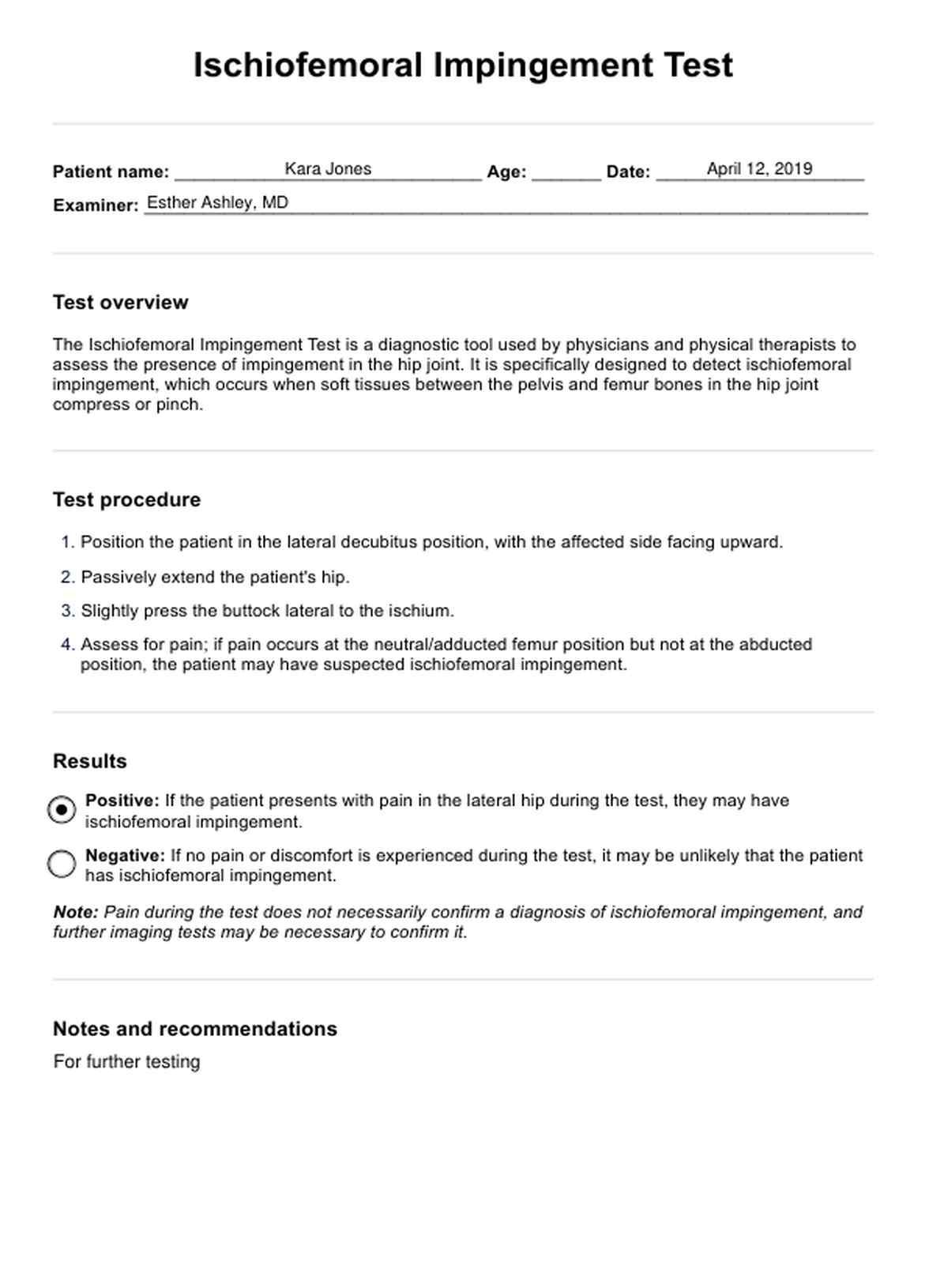Ischiofemoral Impingement Test
Discover the Ischiofemoral Impingement Test, a diagnostic tool for hip pain caused by entrapment of the quadratus femoris muscle and sciatic nerve.


What is ischiofemoral impingement (IFI) syndrome?
Ischiofemoral impingement syndrome (IFI) occurs when the space between the ischial tuberosity (also known as the "sit bones") and the greater trochanter of the femur becomes too small. This can lead to compression or impingement of soft tissues, such as muscles and nerves, in this area.
IFI syndrome is also known by other names, such as posterior hip impingement syndrome, deep gluteal syndrome, and proximal hamstring tendinopathy. It is considered a relatively rare condition and often goes undiagnosed or misdiagnosed.
Symptoms of this syndrome
This syndrome manifests as posterior hip pain, which may radiate to the groin, buttock, or thigh. Patients often describe the pain as a deep, aching sensation that worsens with specific movements of the hip joint. The following are common symptoms associated with this syndrome:
- Persistent pain localized to the posterior hip, often exacerbated by hip extension, adduction, and external rotation.
- Pain that extends from the hip to the gluteal region, sometimes mimicking sciatica due to the proximity of the sciatic nerve.
- A sensation of snapping or clicking in the hip joint during movement, particularly during hip extension and adduction.
- Due to pain and discomfort, there is limited hip flexion, internal rotation, and external rotation.
- Discomfort extending to the groin area is often linked with hip impingement.
Causes of this syndrome
Key causes include:
- Structural abnormalities such as coxa valga and prominence of the lesser trochanter can predispose individuals to IFI.
- Previous hip surgeries, including total hip arthroplasty and proximal femoral osteotomy, can alter the alignment of the hip joint and lead to impingement. Trauma to the hip region can also cause similar changes.
- Weakness in the hip abductors, adductors, and other surrounding muscles can result in improper hip mechanics, increasing the risk of impingement.
- Activities involving repetitive hip extension and external rotation, such as running and dancing, can contribute to the development of this syndrome.
- Conditions such as hamstring tendon edema, iliopsoas tendon abnormalities, and quadratus femoris tendinitis can exacerbate the narrowing of the ischiofemoral space.
Ischiofemoral Impingement Test Template
Ischiofemoral Impingement Test Example
What is the Ischiofemoral Impingement Test?
The Ischiofemoral Impingement Test is a diagnostic tool used by physicians and physical therapists to assess the presence of impingement in the hip joint. It is specifically designed to detect ischiofemoral impingement, which occurs when soft tissues between the pelvis and femur bones in the hip joint compress or pinch.
Here's how to perform the test (Wu et al., 2023):
- Position the patient in the lateral decubitus position, with the affected side facing upward.
- Passively extend the patient's hip.
- Slightly press the buttock lateral to the ischium.
- Assess for pain; if pain occurs at the neutral/adducted femur position but not at the abducted position, the patient may have suspected ischiofemoral impingement.
A positive result may be compression or pinching of soft tissues in the ischiofemoral space, causing impingement. This test is usually used in conjunction with other physical examination techniques and imaging studies to confirm the diagnosis of ischiofemoral impingement.
It is important to note that a positive result on this test does not necessarily mean that surgery is required. Many cases of ischiofemoral impingement can be managed through conservative treatments such as physical therapy, stretching exercises, and anti-inflammatory medication.
Treatment options
Patients with IFI can find relief through a combination of non-surgical and surgical treatments. The chosen treatment will depend on the severity of symptoms, underlying causes, and individual needs .
Conservative treatments
Conservative management is the first line of treatment for this syndrome and typically includes physical therapy aimed at strengthening the hip abductors and adductors and improving hip mechanics. Anti-inflammatory medications can assist in pain reduction and managing inflammation(Gollwitzer et al., 2017).
Hip preservation surgery
In cases where conservative treatments are ineffective, this type of hip surgery may be considered to alleviate pain and correct hip abnormalities. Surgical approaches can include the resection of the lesser trochanter to increase the space within the hip joint, thereby relieving impingement. Additionally, addressing abnormalities of the quadratus femoris muscle, such as removing fibrosis or scar tissue, can significantly reduce discomfort.
Specific treatments for muscle abnormalities
Addressing issues in the left quadratus femoris muscle or any abnormalities identified in this region is crucial for relieving and managing hip pain and abnormalities. Procedures targeting the quadratus femoris can include releasing the tension or excising any part of the muscle contributing to the impingement.
References
Gollwitzer, H., Banke, I. J., Schauwecker, J., Gerdesmeyer, L., & Suren, C. (2017). How to address ischiofemoral impingement? Treatment algorithm and review of the literature. Journal of Hip Preservation Surgery, 4(4), 289–298. https://doi.org/10.1093/jhps/hnx035
Wu, W.-T., Chang, K.-V., Mezian, K., Naňka, O., Ricci, V., Chang, H.-C., Wang, B., Hung, C.-Y., & Özçakar, L. (2023). Ischiofemoral impingement syndrome: Clinical and imaging/guidance issues with special focus on ultrasonography. Diagnostics, 13(1), 139. https://doi.org/10.3390/diagnostics13010139
Commonly asked questions
Treatment for the syndrome involves methods like rest, physical therapy, and NSAIDs. Endoscopic treatment or arthroscopic resection may be necessary to address it and relieve gluteal pain.
Hip impingement syndrome is treated with physical therapy, activity modification, NSAIDs, and surgical treatment to address the cause of hip pain and improve hip function.
The fastest way to fix hip impingement involves a combination of physical therapy and targeted exercises.
Hip impingement can lead to chronic pain, limited mobility, and progressive joint damage, potentially resulting in osteoarthritis and the need for more extensive surgical treatment.
The quadratus femoris space is an anatomical region located between the ischium and the femur. In cases of ischiofemoral impingement, this space often becomes narrowed, leading to entrapment of the quadratus femoris muscle. This entrapment results in hip pain, particularly in the entity of hip impingement syndrome, and can be a significant source of left hip pain if the left side is affected.






































































































